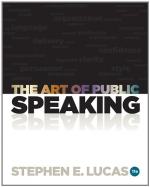Extemporaneous Speech
Surely this is the ideal method of delivery. It is far and away the most popular with the audience, and the favorite method of the most efficient speakers.
“Extemporaneous speech” has sometimes been made to mean unprepared speech, and indeed it is too often precisely that; but in no such sense do we recommend it strongly to speakers old and young. On the contrary, to speak well without notes requires all the preparation which we discussed so fully in the chapter on “Fluency,” while yet relying upon the “inspiration of the hour” for some of your thoughts and much of your language. You had better remember, however, that the most effective inspiration of the hour is the inspiration you yourself bring to it, bottled up in your spirit and ready to infuse itself into the audience.
If you extemporize you can get much closer to your audience. In a sense, they appreciate the task you have before you and send out their sympathy. Extemporize, and you will not have to stop and fumble around amidst your notes—you can keep your eye afire with your message and hold your audience with your very glance. You yourself will feel their response as you read the effects of your warm, spontaneous words, written on their countenances.
Sentences written out in the study are liable to be dead and cold when resurrected before the audience. When you create as you speak you conserve all the native fire of your thought. You can enlarge on one point or omit another, just as the occasion or the mood of the audience may demand. It is not possible for every speaker to use this, the most difficult of all methods of delivery, and least of all can it be used successfully without much practise, but it is the ideal towards which all should strive.
One danger in this method is that you may be led aside from your subject into by-paths. To avoid this peril, firmly stick to your mental outline. Practise speaking from a memorized brief until you gain control. Join a debating society—talk, talk, TALK, and always extemporize. You may “make a fool of yourself” once or twice, but is that too great a price to pay for success?
Notes, like crutches, are only a sign of weakness. Remember that the power of your speech depends to some extent upon the view your audience holds of you. General Grant’s words as president were more powerful than his words as a Missouri farmer. If you would appear in the light of an authority, be one. Make notes on your brain instead of on paper.
Joint Methods of Delivery
A modification of the second method has been adopted by many great speakers, particularly lecturers who are compelled to speak on a wide variety of subjects day after day; such speakers often commit their addresses to memory but keep their manuscripts in flexible book form before them, turning several pages at a time. They feel safer for having a sheet-anchor to windward—but it is an anchor, nevertheless, and hinders rapid, free sailing, though it drag never so lightly.




